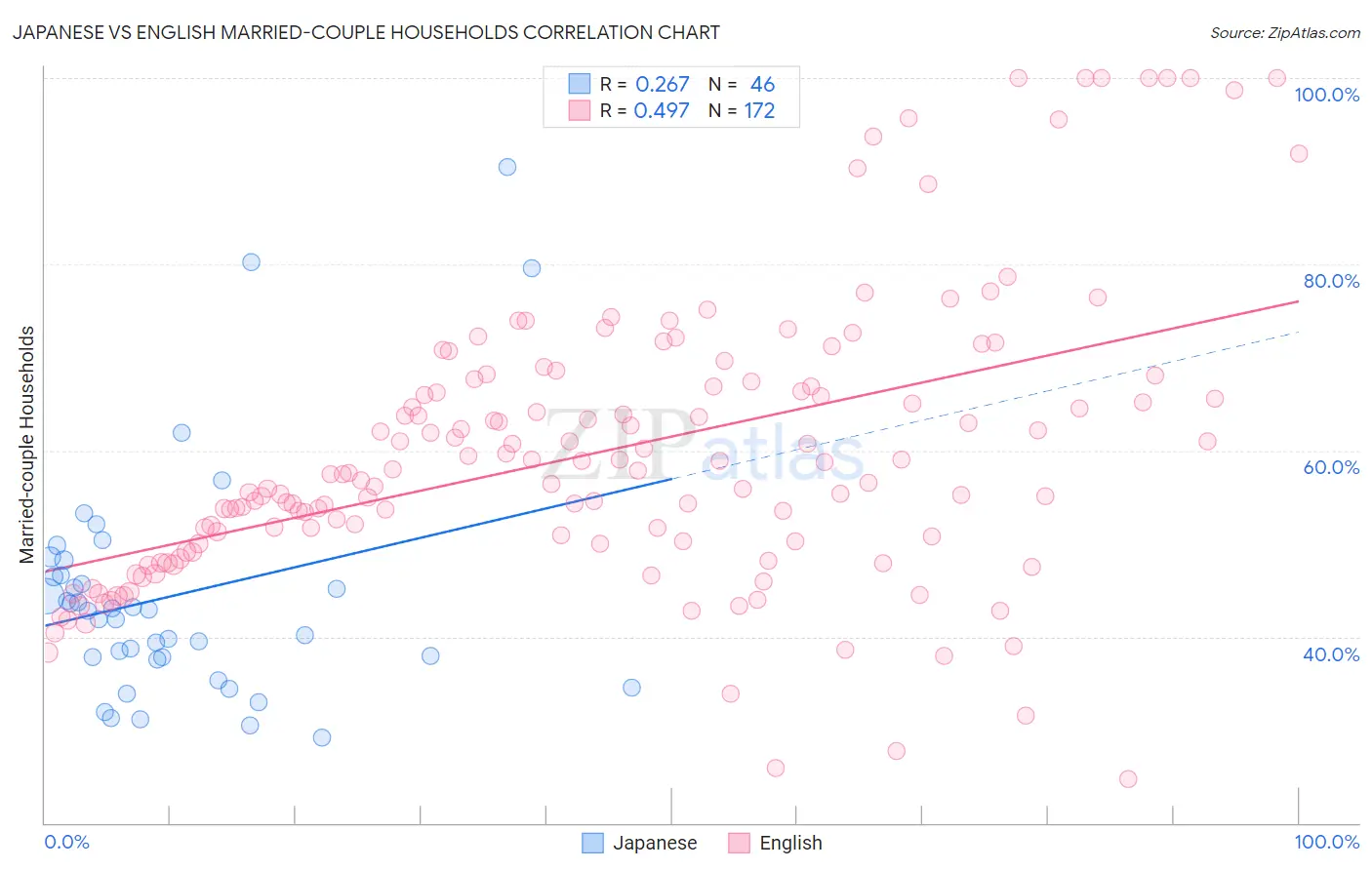Japanese vs English Married-couple Households
COMPARE
Japanese
English
Married-couple Households
Married-couple Households Comparison
Japanese
English
45.2%
MARRIED-COUPLE HOUSEHOLDS
5.7/ 100
METRIC RATING
214th/ 347
METRIC RANK
49.6%
MARRIED-COUPLE HOUSEHOLDS
99.9/ 100
METRIC RATING
18th/ 347
METRIC RANK
Japanese vs English Married-couple Households Correlation Chart
The statistical analysis conducted on geographies consisting of 249,071,577 people shows a weak positive correlation between the proportion of Japanese and percentage of married-couple family households in the United States with a correlation coefficient (R) of 0.267 and weighted average of 45.2%. Similarly, the statistical analysis conducted on geographies consisting of 579,267,782 people shows a moderate positive correlation between the proportion of English and percentage of married-couple family households in the United States with a correlation coefficient (R) of 0.497 and weighted average of 49.6%, a difference of 9.8%.

Married-couple Households Correlation Summary
| Measurement | Japanese | English |
| Minimum | 29.2% | 24.7% |
| Maximum | 90.5% | 100.0% |
| Range | 61.3% | 75.3% |
| Mean | 44.4% | 59.7% |
| Median | 42.9% | 57.5% |
| Interquartile 25% (IQ1) | 37.8% | 50.0% |
| Interquartile 75% (IQ3) | 46.6% | 66.9% |
| Interquartile Range (IQR) | 8.8% | 16.9% |
| Standard Deviation (Sample) | 12.6% | 15.3% |
| Standard Deviation (Population) | 12.5% | 15.3% |
Similar Demographics by Married-couple Households
Demographics Similar to Japanese by Married-couple Households
In terms of married-couple households, the demographic groups most similar to Japanese are Yakama (45.2%, a difference of 0.020%), Immigrants from Nepal (45.2%, a difference of 0.020%), Immigrants from Portugal (45.2%, a difference of 0.020%), Panamanian (45.2%, a difference of 0.040%), and Immigrants from the Azores (45.2%, a difference of 0.070%).
| Demographics | Rating | Rank | Married-couple Households |
| Immigrants | France | 8.8 /100 | #207 | Tragic 45.4% |
| Hispanics or Latinos | 8.7 /100 | #208 | Tragic 45.4% |
| Immigrants | Uzbekistan | 8.4 /100 | #209 | Tragic 45.4% |
| Cubans | 7.7 /100 | #210 | Tragic 45.4% |
| Immigrants | Spain | 7.3 /100 | #211 | Tragic 45.3% |
| Creek | 6.4 /100 | #212 | Tragic 45.3% |
| Yakama | 5.8 /100 | #213 | Tragic 45.2% |
| Japanese | 5.7 /100 | #214 | Tragic 45.2% |
| Immigrants | Nepal | 5.6 /100 | #215 | Tragic 45.2% |
| Immigrants | Portugal | 5.6 /100 | #216 | Tragic 45.2% |
| Panamanians | 5.5 /100 | #217 | Tragic 45.2% |
| Immigrants | Azores | 5.3 /100 | #218 | Tragic 45.2% |
| Nicaraguans | 5.3 /100 | #219 | Tragic 45.2% |
| Immigrants | Thailand | 5.1 /100 | #220 | Tragic 45.2% |
| Tlingit-Haida | 4.9 /100 | #221 | Tragic 45.1% |
Demographics Similar to English by Married-couple Households
In terms of married-couple households, the demographic groups most similar to English are Immigrants from Hong Kong (49.6%, a difference of 0.010%), Swedish (49.7%, a difference of 0.16%), European (49.6%, a difference of 0.16%), Scandinavian (49.6%, a difference of 0.17%), and Korean (49.7%, a difference of 0.19%).
| Demographics | Rating | Rank | Married-couple Households |
| Immigrants | Pakistan | 100.0 /100 | #11 | Exceptional 50.1% |
| Swiss | 100.0 /100 | #12 | Exceptional 49.9% |
| Immigrants | Korea | 100.0 /100 | #13 | Exceptional 49.9% |
| Burmese | 100.0 /100 | #14 | Exceptional 49.8% |
| Koreans | 99.9 /100 | #15 | Exceptional 49.7% |
| Swedes | 99.9 /100 | #16 | Exceptional 49.7% |
| Immigrants | Hong Kong | 99.9 /100 | #17 | Exceptional 49.6% |
| English | 99.9 /100 | #18 | Exceptional 49.6% |
| Europeans | 99.9 /100 | #19 | Exceptional 49.6% |
| Scandinavians | 99.9 /100 | #20 | Exceptional 49.6% |
| Norwegians | 99.9 /100 | #21 | Exceptional 49.5% |
| Asians | 99.9 /100 | #22 | Exceptional 49.5% |
| Dutch | 99.9 /100 | #23 | Exceptional 49.5% |
| Czechs | 99.9 /100 | #24 | Exceptional 49.4% |
| Immigrants | Philippines | 99.9 /100 | #25 | Exceptional 49.3% |